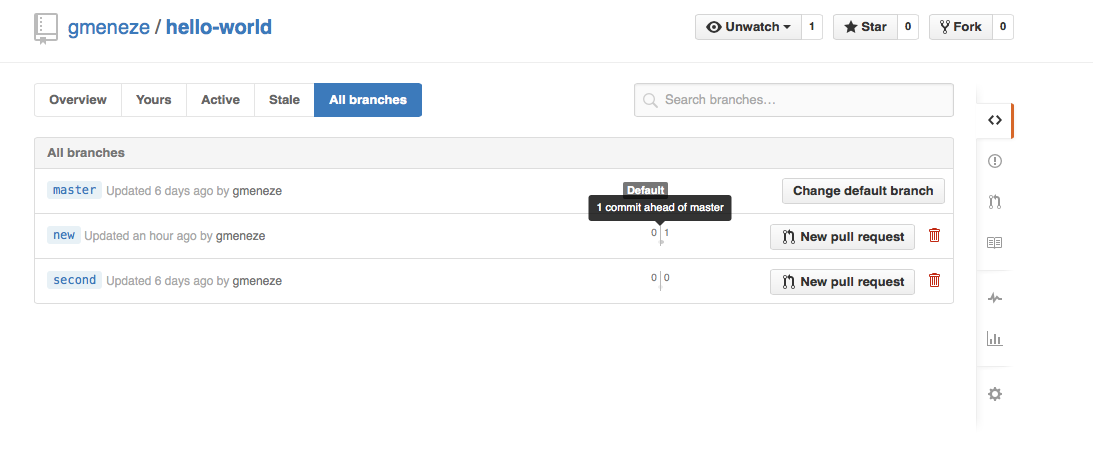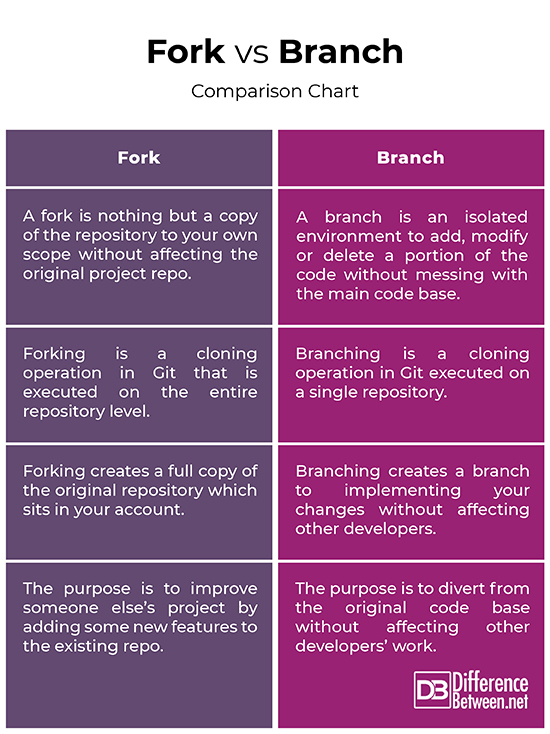Difference Between Fork and Branch
We are living in a world where collaboration prevails over everything, especially in the context of coding. Whether you’re just starting your journey, write fairly complex codes, or working with a team, you are more likely using one of the most used tools for collaborative coding, GitHub.
GitHub, with over 100 million repositories, is undoubtedly the No.1 code hosting platform out there. The very first thing to understand when working with Git is its management of files and folders within the repository. Apart from the tree-like hierarchical structure of the files, GitHub offers some exceptional features to bring the best of Git to your browser. Some of these features include branching, forking, cloning, etc.
We take a look at the two Git mechanisms to better understand how they fit into the whole narrative.

What is Fork?
So, you are using GitHub for a while now? Every now and then, there comes a time when you want to work on someone else’s project or contribute something. Maybe sometimes you’d want to work on projects where you are not the owner or collaborator. In such situations where you do not have a push access to an existing project, you have an option of forking the repository.
So, what is a fork? A fork is nothing but a copy of the repository and you get to work on someone else’s project freely without affecting the project. So, forking basically means creating a copy of the repo on your GitHub account without having to bother adding users as collaborators allowing them push access. You can fork a project, push to it, and contribute the changes back to the original repository via what is known as a Pull Request.

What is Branch?
A branch in Git is just like a branch of a tree. A branch is a massive part of Git and probably one of the best features of Git. When you create a new repository, what you actually do is create a master branch and when you’re making commits, you only commit to this master branch. This master branch typically represents a stable version of your code and this will be the code which is released or published.
So, this is the reason you do not probably want to try out new features or new code on this master branch. So, if you want to add a new feature to your application you’d have to create some kind of isolated environment to try out new features and if this works, you can go ahead and merge them into the master branch.
This is branching is all about; it is a Git function that essentially makes a copy of the code, allowing you to make changes on a particular copy and then merging the changes back to the master branch.
Difference between Fork and Branch
What is the Meaning of Fork vs Branch
– Branching is probably one of the fundamental features available in most modern version control systems. A branch in Git is an isolated environment to add, modify or delete a portion of the code without messing with the main code of the project.
Branching is to create another line of development in the project without affecting the main branch or repository. Forking, on the other hand, is to make a clone of the repository on your GitHub account without affecting the main repository.
A fork is nothing but a duplicate copy of someone else’s project, whereas a branch is just a version of a repository.
So what is the Function of Fork vs Branch
– Forking is functionally similar to branching in other version control systems, but in Git, branching is an entirely different feature which is based on a similar analogy involving trees. Inherently, there is no fundamental difference between the two, except branching typically is a cloning operation in Git executed on a single repository.
Forking, on the other hand, is a cloning operation in Git that is executed on the entire repository level. Forking creates a full copy of the original repository without affecting the main repository and the copy sits in your account whereas branching creates a branch to encapsulate your changes.
How about the Purpose of Fork vs Branch?
– When you want to work on or contribute to someone else’s project, you create a personal copy of the repository which acts like a bridge between the main repo and the copy.
This personal copy is what we call a fork. So, the purpose of forking in Git is to improve someone else’s project by adding some new features or functionalities to the existing repo. Git branches, on the other hand, act as pointers to the snapshots of the changes.
So, when you wish to make some changes to the code, you divert from the original code base by creating a branch so that you could work freely without affecting work of other developers on the team.
Fork vs. Branch: Comparison Chart

Summary of Fork vs. Branch
So in a nutshell, every time you make a copy of a repository, you are creating a fork and the whole action is viewed as forking the project.
If you want to modify or add code to a project, whether it’s your own solo project or a large open-source project, you are likely to create a branch, which will specifically store all the code.
Branching is a Git operation that essentially makes a copy of a code wherein each branch represents a copy of the code. This way you can modify your personal copy and then if it works, merge your changes back to the master branch. So, functionally, forking and branching are quite similar but with different intents.
- Difference Between Caucus and Primary - June 18, 2024
- Difference Between PPO and POS - May 30, 2024
- Difference Between RFID and NFC - May 28, 2024
Search DifferenceBetween.net :
1 Comment
Leave a Response
References :
[0]Pipinellis, Achilleas. GitHub Essentials: Unleash the power of collaborative development workflows using GitHub, 2nd Edition. Birmingham, United Kingdom: Packt Publishing, 2018. Print
[1]Guthals, Sarah and Phil Haack. GitHub for Dummies. New Jersey, United States: John Wiley & Sons, 2019. Print
[2]Chacon, Scott and Ben Straub. Pro Git. New York, United States: Apress, 2014. Print
[3]Loeliger, Jon. Version Control with Git: Powerful Tools and Techniques for Collaborative Software Development. Massachusetts, United States: O'Reilly Media, 2009. Print
[4]Santacroce, Ferdinando et al. Git: Mastering Version Control. Birmingham, United Kingdom: Packt Publishing, 2016. Print
[5]Image credit: https://commons.wikimedia.org/wiki/File:Screen_Shot_-_Branches_-_2.png
[6]Image credit: https://commons.wikimedia.org/wiki/File:Fork_button.jpg

good job but after several reads, I was non the wiser than when I first read this in search for the difference between Fork F & Branch B functions
Here’s what you failed to discern >>
Ownership O and control C of the Git Repo R
This is the important discriminant between F & B
F retains original O&C i.e the owner of the repo retains control and ownership of changes to the code base
B creates a new but linked R under new O&C of the new owner that created the Branch i.e you control what happens to the codebase of your branch
also visibility